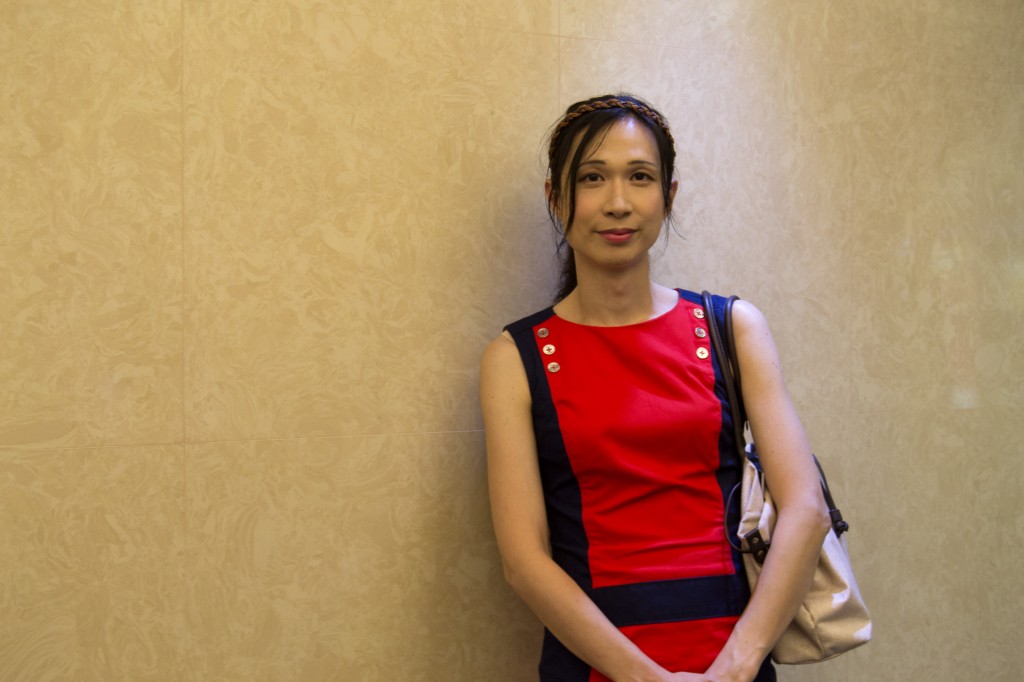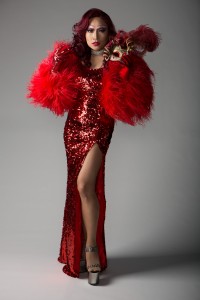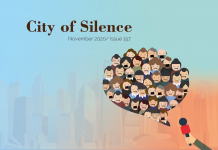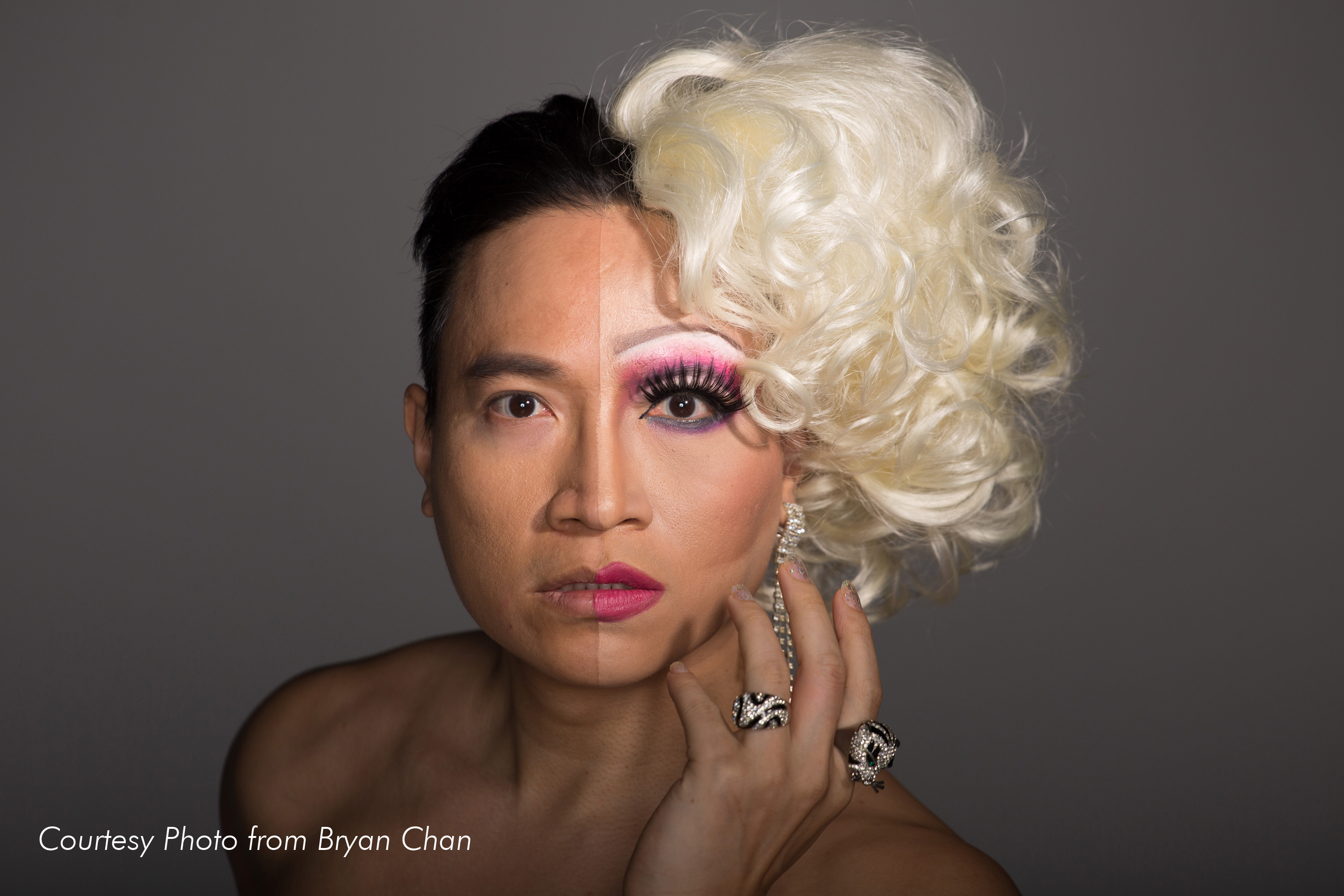Expressing individuality through cross-dressing
by Jeffery Loa

A slender lady dressed in a chic navy and red dress sits down elegantly and takes out a mirror. She meticulously applies her lipstick, oblivious to the gaze of passers-by.
“I get used to the gaze. At the very beginning, of course I minded. But now I know that I want to be a woman, I dress like a woman,’’ she says.
This is Beavis Wong Pak-fai, a 34-year-old who was born a biological male but identifies as female. Wong is receiving counselling for Gender Identity Disorder and is considering sex reassignment surgery. In the meantime, she says, “Cross-dressing is a platform for me to try dressing like a lady. I can find myself when looking at mirrors.”
Cross-dressing is the practice of wearing clothes traditionally worn by the opposite sex. Cross-dressers are a sub-group under the transgender family which includes transsexuals as well as those who are comfortable with their biological gender. Strictly speaking, anyone can be a cross-dresser, regardless of their biological sex and sexual orientation.
Living in a city where traditional ideas about gender roles and expectations are deeply entrenched, it is very hard for individuals to break gender norms. For many people, dresses are women’s attire and men should not wear them. But Wong has always been fascinated by dresses.
Wong recalls that as a child, she used to observe women wearing long dresses in the street. She would cut out appealing photos of women from magazines and arrange them tidily in a folder.
While still at primary school, she started to secretly wear her mother’s dresses, but was disappointed that she only had a few.
In her teens, she saved up pocket money to buy dresses. To keep them a secret from her mother, the young Beavis locked the women’s clothes in a metallic box and placed a bunch of compact discs on top to cover them.
It was not until her twenties that Wong began to cross-dress in public. But the transformation was prolonged and gradual. First, she started off with gender-neutral outfits – from trousers, to shorts with leggings to long dresses.
Because the transformation was gradual, Wong’s mother reacted rather calmly when she learned of the situation. Once, when Wong was in hospital suffering from enterogastritis, she did not have time to hide her women’s clothing. Her mother discovered the stash, and that was when Wong confessed to suffering from Gender Identity Disorder, where one has a strong feeling of identification with the opposite gender.
“She noticed that I’m changing. She wants to know the answer,’’ says Wong. Nowadays, she makes sure she is always well dressed when meeting her mother. She wears dresses with high heels and applies makeup. Her mother even reminds her to not be too sexy.
Apart from her mother, Wong’s colleagues are also unperturbed by the gradual change in her appearance. She sometimes goes to work as an assistant information technology officer in a dress and full makeup.
Although Wong is not directly criticised by her colleagues, she does hear some tittle-tattle about the way she looks. “I don’t care too much. I’m there to perform my job,’’ says Wong.
However, like many other cross-dressers, Wong does not dare to buy women’s clothes in boutiques, out of fear that she will be stared at and insulted.
Apart from online shopping, Wong says there are strategies to cope with these situations. For example, she would pretend to be buying clothes for a girlfriend, for a drama performance or for her course work as a fashion student.
Going to the washroom is another problem. Wong says it is embarrassing for her to enter the men’s toilet in women’s dress. When she does, she is often scolded loudly by the astonished men in the toilet.
Wong’s experiences are shared by Jaco Fok Chi-hin, another male cross-dresser. Fok, who is 22, first cross-dressed in public when he took part in a magic show at university a year ago.

Fok says he is often glared at by passers-by when he is walking in the street. “A stare may be more disturbing than a word,” he says.
And unlike Wong, Fok tries not to let his mother see him dressed as a woman, even though he has told her in the past that he wants to be a girl. Instead, he often goes home at midnight when his mum is already asleep. “I believe that she cannot completely accept it, but at least I feel happy that she tries to understand.’’
Wong and Fok may find varying degrees of disapproval from mainstream society for cross-dressing in daily life, but society seems to be more accepting of men dressed as women in the context of “drag”. Drag is a performance in which a man cross-dresses and acts in an exaggerated manner.
Cross-dressing and drag are often lumped together but while they share some similarities, there are also differences.
Bryan Chan, the 41-year-old owner of a production company, sometimes transforms himself into a glamourous singer and drag queen, Coco Pop.
Back in 2002, Bryan was invited by his friends to join a drag performance competition in a bar. Unexpectedly, he was picked as the first-runner up despite his slapdash makeup and choice of costumes. Since then, Chan has firmly believed he was born to be a drag queen.
Chan says that unlike cross-dressing, drag is about the business of entertaining audiences. Drag queens seek and thrive on the attention – the audience’s screams, admiration and compliments delight them.
As doing drag is a performance rather than a daily-life practice, drag queens dress in a more flamboyant and extravagant style than cross-dressers do. They pay close attention to styling, hair and make-up. Chan says it can take him up to six hours to complete his look. For events like Halloween, drag queens may prepare their outfits a week beforehand.

(Courtesy photo from Bryan Chan)
To achieve perfection, Chan designs his own costumes and sometimes uses several hairpieces together. He says performing in drag empowers him, it releases the qualities hidden deep in his heart – the desire to rebel and dominate.
Whether it is everyday cross-dressing or drag, the impulse to cross gender boundaries is a form of expression. And for Jaco Fok it is a kind of expression that is more frowned upon when it is adopted by men than when it is adopted by women.
Fok says female cross-dressers are by and large better accepted by society than male ones. He attributes this to traditional patriarchal Chinese culture where men have higher social status and are subject to more rigid expectations than in societies where men and women are more equal.
Joseph Cho Man-kit, a lecturer of the Gender Studies Programme at the Chinese University of Hong Kong, relates the phenomenon to the gender hierarchy. Since men have a more prestigious status in society, females acting in a masculine way are considered to be moving up in the hierarchy. Whilst for a male to dress in a feminine way is considered a demotion, giving rise to the conception that cross-dressing is deviant.
This is exacerbated by homophobia, as the public often equates cross-dressers with homosexuals. Whereas Cho points out that most cross-dressers are heterosexual.
Wayne Wong Wing-tung, a photographer, likes wearing boyish clothing. However, she never labels herself as a cross-dresser.
“If such a minor thing [the choice of clothing] has to be labelled, there will be many meaningless labels,” says Wayne.
To Wong, clothing is not about constructing a new gender identity, it is more about convenience. As Wong’s job involves dealing with consumers and moving heavy audio-visual equipment, adopting a boyish style and wearing “masculine” outfits saves her a lot of time.
Wong believes that with the popularity of the Korean fashion wave, the gender boundaries in fashion and the stigma of male cross-dressers will fade out soon.
Daisy Chow Hoi-sze, a clinical psychologist at the Cheers Psychological Consultancy Services, says that within the mental health community, there is a tendency for cross-dressing to be de-pathologised.
Chow says as society’s culture changes, health professionals are re-considering whether cross-dressing should be considered a “disease” or condition. This is similar to homosexuality which had previously been defined as a mental illness.
The tide may be turning slowly, but for some, this is immaterial. Despite the glares and the hushed murmurings behind their backs, they are proud to just be themselves.
As Bryan Chan, a.k.a. Coco Pop says, “I am not born to meet the expectations projected by society. Even if you don’t like it, you can only accept it or stand aside.”
Edited by Silvia Li











































